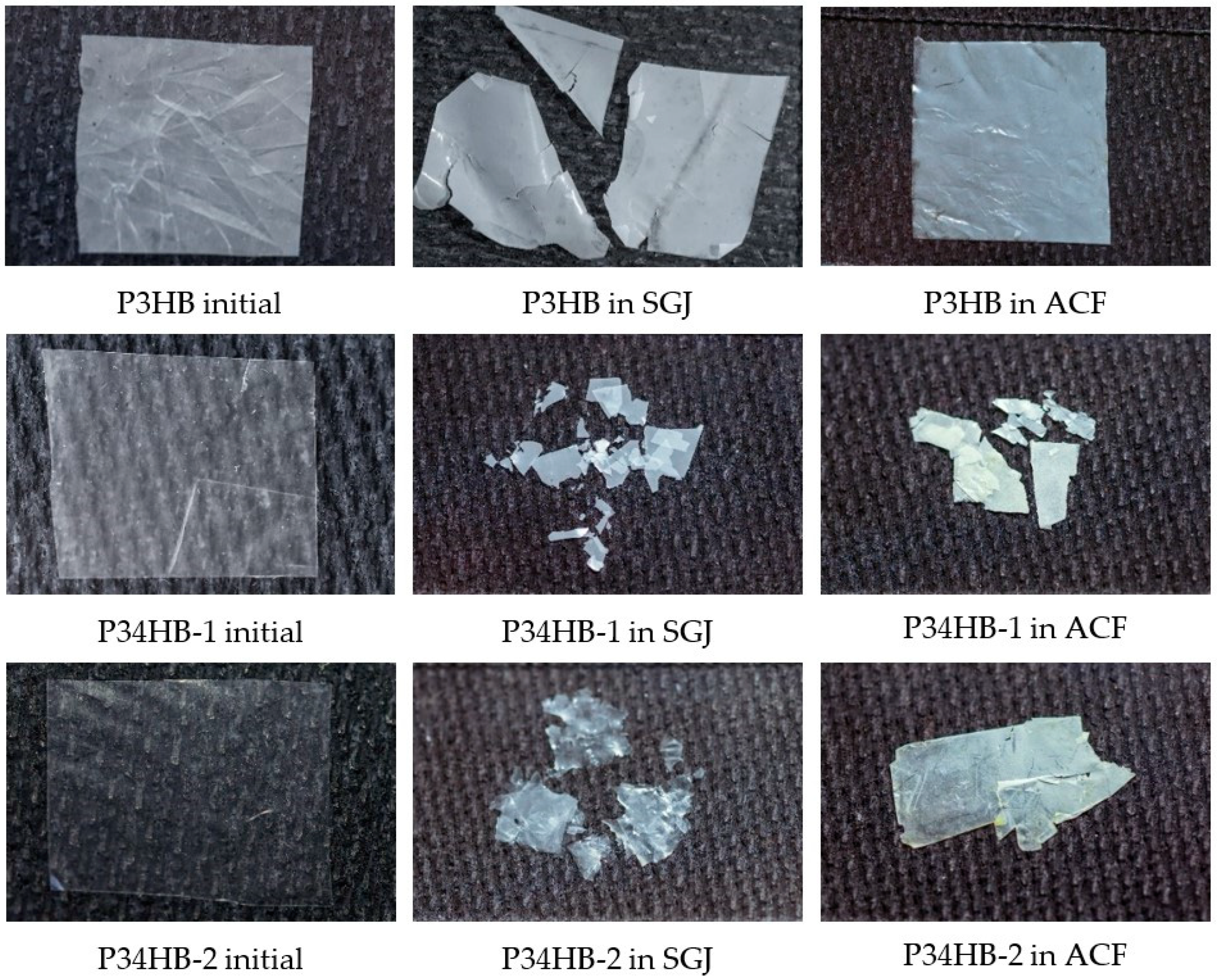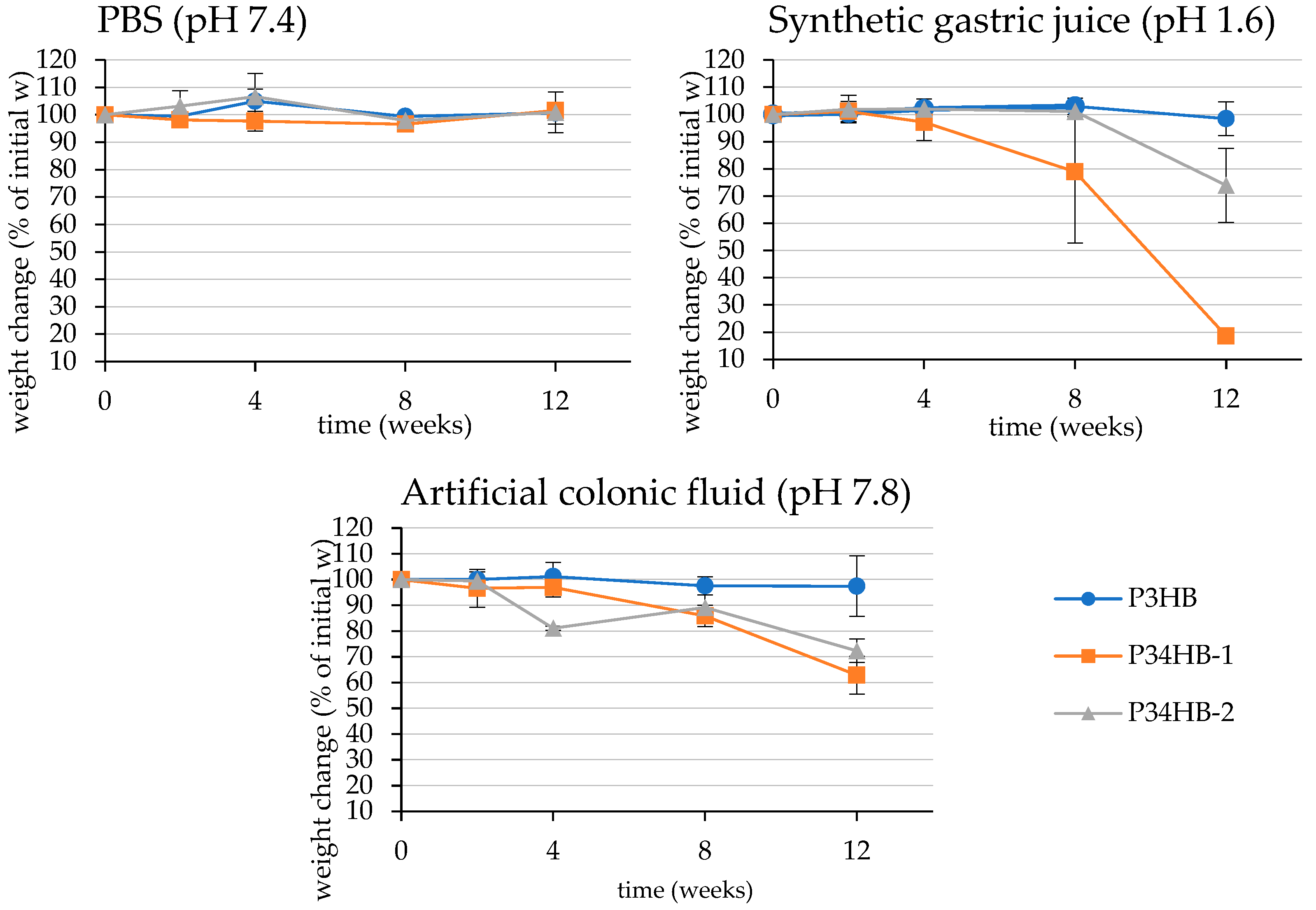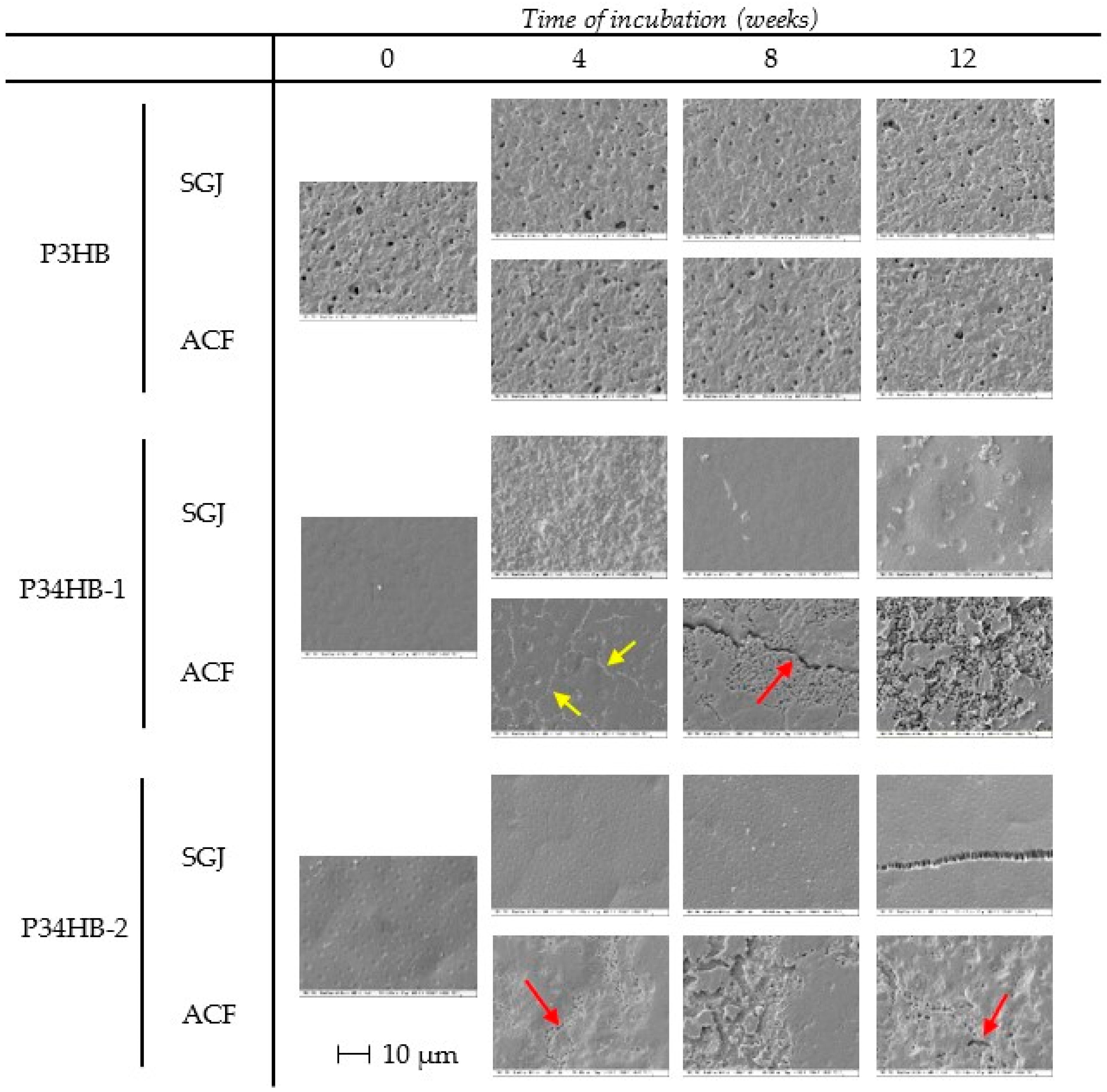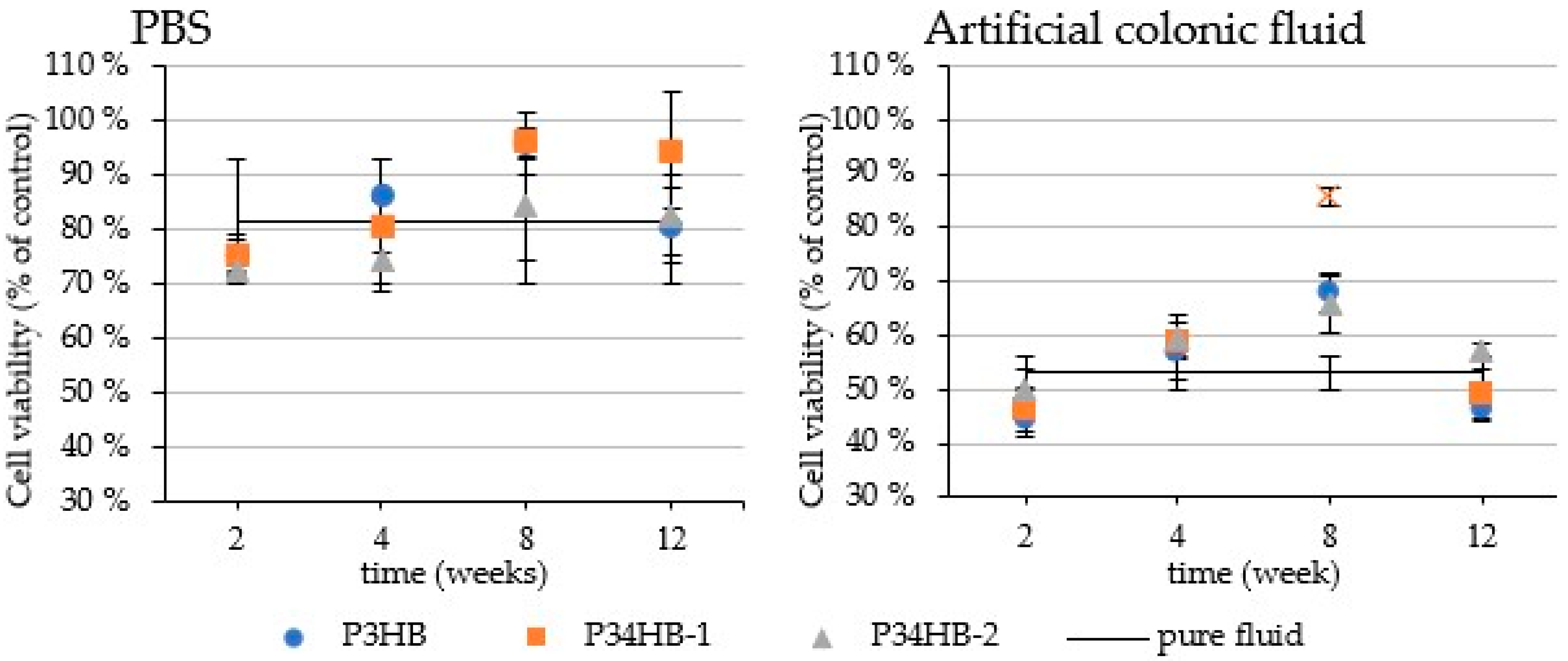Degradation of P(3HB-co-4HB) Films in Simulated Body Fluids
Abstract
:1. Introduction
2. Materials and Methods
2.1. Preparation of Polymer Films
2.2. Biodegradation in Simulated Body Fluids
2.3. Molecular Weight Measurements
2.4. DSC Measurements
2.5. Detection of Degradation Products
2.6. Surface Imaging
2.7. Cytotoxicity Tests
2.8. Statistical Analysis
3. Results and Discussion
3.1. Weight Changes
3.2. Molecular Weight Changes
3.3. Changes in Thermal Properties
3.4. Detection of Degradation Products
3.5. Surface Changes
3.6. Cytotoxicity Tests
4. Conclusions
Supplementary Materials
Author Contributions
Funding
Informed Consent Statement
Data Availability Statement
Acknowledgments
Conflicts of Interest
References
- Koller, M.; Mukherjee, A. A New Wave of Industrialization of PHA Biopolyesters. Bioengineering 2022, 9, 74. [Google Scholar] [CrossRef] [PubMed]
- Utsunomia, C.; Ren, Q.; Zinn, M. Poly(4-Hydroxybutyrate): Current State and Perspectives. Front. Bioeng. Biotechnol. 2020, 8, 257. [Google Scholar] [CrossRef] [PubMed] [Green Version]
- Jendrossek, D.; Handrick, R. Microbial Degradation of Polyhydroxyalkanoates. Annu. Rev. Microbiol. 2002, 56, 403–432. [Google Scholar] [CrossRef] [PubMed]
- Koller, M.; Mukherjee, A. Polyhydroxyalkanoates—Linking Properties, Applications and End-of-life Options. Chem. Biochem. Eng. Q. 2020, 34, 115–129. [Google Scholar] [CrossRef]
- Jaeger, E.K.; Steinbüchel, A.; Jendrossek, D. Substrate specificities of bacterial polyhydroxyalkanoate depolymerases and lipases: Bacterial lipases hydrolyze poly(omega-hydroxyalkanoates). Appl. Environ. Microbiol. 1995, 61, 3113–3118. [Google Scholar] [CrossRef] [Green Version]
- Mok, P.-S.; Ch’Ng, D.H.-E.; Ong, S.-P.; Numata, K.; Sudesh, K. Characterization of the depolymerizing activity of commercial lipases and detection of lipase-like activities in animal organ extracts using poly(3-hydroxybutyrate-co-4-hydroxybutyrate) thin film. AMB Express 2016, 6, 97. [Google Scholar] [CrossRef] [Green Version]
- Keridou, I.; Franco, L.; Del Valle, L.J.; Martínez, J.C.; Funk, L.; Turon, P.; Puiggalí, J. Microstructural Changes during Degradation of Biobased Poly(4-Hydroxybutyrate) Sutures. Polymers 2020, 12, 2024. [Google Scholar] [CrossRef] [PubMed]
- Keridou, I.; Franco, L.; del Valle, L.J.; Martínez, J.C.; Funk, L.; Turon, P.; Puiggalí, J. Hydrolytic and enzymatic degradation of biobased poly(4-hydroxybutyrate) films. Selective etching of spherulites. Polym. Degrad. Stab. 2020, 183, 109451. [Google Scholar] [CrossRef]
- Boyandin, A.N.; Prudnikova, S.V.; Filipenko, M.L.; Khrapov, E.A.; Vasil’Ev, A.D.; Volova, T.G. Biodegradation of polyhydroxyalkanoates by soil microbial communities of different structures and detection of PHA degrading microorganisms. Appl. Biochem. Microbiol. 2011, 48, 28–36. [Google Scholar] [CrossRef]
- Prudnikova, S.V.; Vinogradova, O.N.; Trusova, M.Y. Specific character of bacterial biodegradation of polyhydroxyalkanoates with different chemical structure in soil. Dokl. Biochem. Biophys. 2017, 473, 94–97. [Google Scholar] [CrossRef]
- Chen, G.-Q.; Wu, Q. The application of polyhydroxyalkanoates as tissue engineering materials. Biomaterials 2005, 26, 6565–6578. [Google Scholar] [CrossRef] [PubMed]
- Luo, Z.; Wu, Y.; Li, Z.; Loh, X.J. Recent Progress in Polyhydroxyalkanoates-Based Copolymers for Biomedical Applications. Biotechnol. J. 2019, 14, 1900283. [Google Scholar] [CrossRef] [PubMed]
- Rodriguez-Contreras, A. Recent Advances in the Use of Polyhydroyalkanoates in Biomedicine. Bioengineering 2019, 6, 82. [Google Scholar] [CrossRef] [PubMed] [Green Version]
- Pernicova, I.; Novackova, I.; Sedlacek, P.; Kourilova, X.; Kalina, M.; Kovalcik, A.; Koller, M.; Nebesarova, J.; Krzyzanek, V.; Hrubanova, K.; et al. Introducing the Newly Isolated Bacterium Aneurinibacillus sp. H1 as an Auspicious Thermophilic Producer of Various Polyhydroxyalkanoates (PHA) Copolymers–1. Isolation and Characterization of the Bacterium. Polymers 2020, 12, 1235. [Google Scholar] [CrossRef]
- Obruca, S.; Benesova, P.; Oborná, J.; Marova, I. Application of protease-hydrolyzed whey as a complex nitrogen source to increase poly(3-hydroxybutyrate) production from oils by Cupriavidus necator. Biotechnol. Lett. 2013, 36, 775–781. [Google Scholar] [CrossRef]
- Marques, M.R.C.; Loebenberg, R.; Almukainzi, M. Simulated Fluids. Dissolution Technol. 2011, 18, 15–28. [Google Scholar] [CrossRef]
- Sedlacek, P.; Pernicova, I.; Novackova, I.; Kourilova, X.; Kalina, M.; Kovalcik, A.; Koller, M.; Nebesarova, J.; Krzyzanek, V.; Hrubanova, K.; et al. Introducing the Newly Isolated Bacterium Aneurinibacillus sp. H1 as an Auspicious Thermophilic Producer of Various Polyhydroxyalkanoates (PHA) Copolymers–2. Material Study on the Produced Copolymers. Polymers 2020, 12, 1298. [Google Scholar] [CrossRef]
- Li, X.; Turánek, J.; Knötigová, P.; Kudláčková, H.; Masek, J.; Parkin, S.; Rankin, S.; Knutson, B.L.; Lehmler, H.-J. Hydrophobic tail length, degree of fluorination and headgroup stereochemistry are determinants of the biocompatibility of (fluorinated) carbohydrate surfactants. Colloids Surf. B Biointerfaces 2009, 73, 65–74. [Google Scholar] [CrossRef] [Green Version]
- Volova, T.G.; Gladyshev, M.I.; Trusova, M.Y.; Zhila, N.O. Degradation of polyhydroxyalkanoates and the composition of microbial destructors under natural conditions. Microbiology 2006, 75, 593–598. [Google Scholar] [CrossRef]
- Qu, X.-H.; Wu, Q.; Zhang, K.-Y.; Chen, G. In vivo studies of poly(3-hydroxybutyrate-co-3-hydroxyhexanoate) based polymers: Biodegradation and tissue reactions. Biomaterials 2006, 27, 3540–3548. [Google Scholar] [CrossRef]
- Boskhomdzhiev, A.P.; Bonartsev, A.P.; Makhina, T.K.; Myshkina, V.L.; Ivanov, E.A.; Bagrov, D.; Filatova, E.V.; Iordanskii, A.L.; Bonartseva, G. Biodegradation kinetics of poly(3-hydroxybutyrate)-based biopolymer systems. Biochem. (Moscow) Suppl. Ser. B Biomed. Chem. 2010, 4, 177–183. [Google Scholar] [CrossRef]
- Gutierrez-Wing, M.T.; Stevens, B.E.; Theegala, C.S.; Negulescu, I.I.; Rusch, K.A. Aerobic Biodegradation of Polyhydroxybutyrate in Compost. Environ. Eng. Sci. 2011, 28, 477–488. [Google Scholar] [CrossRef]
- Deroiné, M.; César, G.; Le Duigou, A.; Davies, P.; Bruzaud, S. Natural Degradation and Biodegradation of Poly(3-Hydroxybutyrate-co-3-Hydroxyvalerate) in Liquid and Solid Marine Environments. J. Polym. Environ. 2015, 23, 493–505. [Google Scholar] [CrossRef] [Green Version]
- Han, J.; Wu, L.; Liu, X.-B.; Hou, J.; Zhao, L.-L.; Chen, J.-Y.; Zhao, D.-H.; Xiang, H. Biodegradation and biocompatibility of haloarchaea-produced poly(3-hydroxybutyrate-co-3-hydroxyvalerate) copolymers. Biomaterials 2017, 139, 172–186. [Google Scholar] [CrossRef] [PubMed]
- Zhuikov, V.A.; Zhuikova, Y.V.; Makhina, T.K.; Myshkina, V.L.; Rusakov, A.; Useinov, A.; Voinova, V.V.; Bonartseva, G.A.; Berlin, A.A.; Bonartsev, A.P.; et al. Comparative Structure-Property Characterization of Poly(3-Hydroxybutyrate-Co-3-Hydroxyvalerate)s Films under Hydrolytic and Enzymatic Degradation: Finding a Transition Point in 3-Hydroxyvalerate Content. Polymers 2020, 12, 728. [Google Scholar] [CrossRef] [Green Version]
- Kovalcik, A.; Obruca, S.; Kalina, M.; Machovsky, M.; Enev, V.; Jakesova, M.; Sobkova, M.; Marova, I. Enzymatic Hydrolysis of Poly(3-Hydroxybutyrate-co-3-Hydroxyvalerate) Scaffolds. Materials 2020, 13, 2992. [Google Scholar] [CrossRef]
- Chuah, J.-A.; Yamada, M.; Taguchi, S.; Sudesh, K.; Doi, Y.; Numata, K. Biosynthesis and characterization of polyhydroxyalkanoate containing 5-hydroxyvalerate units: Effects of 5HV units on biodegradability, cytotoxicity, mechanical and thermal properties. Polym. Degrad. Stab. 2012, 98, 331–338. [Google Scholar] [CrossRef]
- Freier, T.; Kunze, C.; Nischan, C.; Kramer, S.; Sternberg, K.; Saß, M.; Hopt, U.T.; Schmitz, K.-P. In vitro and in vivo degradation studies for development of a biodegradable patch based on poly(3-hydroxybutyrate). Biomaterials 2002, 23, 2649–2657. [Google Scholar] [CrossRef]
- YDoi, Y.; Kanesawa, Y.; Kunioka, M.; Saito, T. Biodegradation of microbial copolyesters: poly(3-hydroxybutyrate-co-3-hydroxyvalerate) and poly(3-hydroxybutyrate-co-4-hydroxybutyrate). Macromolecules 1990, 23, 26–31. [Google Scholar] [CrossRef]
- Bonartsev, A.; Boskhomodgiev, A.P.; Iordanskii, A.L.; Bonartseva, G.; Rebrov, A.V.; Makhina, T.K.; Myshkina, V.L.; Yakovlev, S.A.; Filatova, E.A.; Ivanov, E.A.; et al. Hydrolytic Degradation of Poly(3-hydroxybutyrate), Polylactide and their Derivatives: Kinetics, Crystallinity, and Surface Morphology. Mol. Cryst. Liq. Cryst. 2012, 556, 288–300. [Google Scholar] [CrossRef]
- Olkhov, A.; Tyubaeva, P.; Vetcher, A.; Karpova, S.; Kurnosov, A.; Rogovina, S.; Iordanskii, A.; Berlin, A. Aggressive Impacts Affecting the Biodegradable Ultrathin Fibers Based on Poly(3-Hydroxybutyrate), Polylactide and Their Blends: Water Sorption, Hydrolysis and Ozonolysis. Polymers 2021, 13, 941. [Google Scholar] [CrossRef] [PubMed]
- Numata, K.; Abe, H.; Iwata, T. Biodegradability of Poly(hydroxyalkanoate) Materials. Materials 2009, 2, 1104–1126. [Google Scholar] [CrossRef]
- Chang, H.-M.; Huang, C.-C.; Tsai, H.-C.; Imae, T.; Hong, P.-D. Characterization and morphology analysis of degradable poly(l-lactide) film in in-vitro gastric juice incubation. Appl. Surf. Sci. 2012, 262, 89–94. [Google Scholar] [CrossRef]
- Tarazona, N.A.; Machatschek, R.; Lendlein, A. Influence of Depolymerases and Lipases on the Degradation of Polyhydroxyalkanoates Determined in Langmuir Degradation Studies. Adv. Mater. Interfaces 2020, 7, 2000872. [Google Scholar] [CrossRef]
- Chang, H.-M.; Prasannan, A.; Tsai, H.-C.; Jhu, J.-J. Ex vivo evaluation of biodegradable poly(ɛ-caprolactone) films in digestive fluids. Appl. Surf. Sci. 2014, 313, 828–833. [Google Scholar] [CrossRef]
- Peng, H.; Ling, J.; Liu, J.; Zhu, N.; Ni, X.; Shen, Z. Controlled enzymatic degradation of poly(ɛ-caprolactone)-based copolymers in the presence of porcine pancreatic lipase. Polym. Degrad. Stab. 2010, 95, 643–650. [Google Scholar] [CrossRef]
- Ladd, M.R.; Costello, C.M.; Gosztyla, C.; Werts, A.D.; Johnson, B.; Fulton, W.B.; Martin, L.Y.; Redfield, E.J.; Crawford, B.; Panaparambil, R.; et al. Development of Intestinal Scaffolds that Mimic Native Mammalian Intestinal Tissue. Tissue Eng. Part A 2019, 25, 1225–1241. [Google Scholar] [CrossRef]
- Wu, L.; Li, X.; Li, P.; Pan, L.; Ji, Z.; Feng, Y.; Shi, C. Bioabsorbable flexible elastomer of PTMC-b-PEG-b-PTMC copolymer as intestinal anastomosis scaffold. Polym. Adv. Technol. 2021, 32, 3633–3645. [Google Scholar] [CrossRef]
- Pernicová, I.; Kucera, D.; Nebesarova, J.; Kalina, M.; Novackova, I.; Koller, M.; Obruca, S. Production of polyhydroxyalkanoates on waste frying oil employing selected Halomonas strains. Bioresour. Technol. 2019, 292, 122028. [Google Scholar] [CrossRef]
- Kourilova, X.; Pernicova, I.; Sedlar, K.; Musilova, J.; Sedlacek, P.; Kalina, M.; Koller, M.; Obruca, S. Production of polyhydroxyalkanoates (PHA) by a thermophilic strain of Schlegelella thermodepolymerans from xylose rich substrates. Bioresour. Technol. 2020, 315, 12388. [Google Scholar] [CrossRef]
- Sabbagh, F.; Muhamad, I.I. Production of poly-hydroxyalkanoate as secondary metabolite with main focus on sustainable energy. Renew. Sustain. Energy Rev. 2017, 72, 95–104. [Google Scholar] [CrossRef]
- Saratale, G.D.; Saratale, R.G.; Varjani, S.; Cho, S.-K.; Ghodake, G.S.; Kadam, A.; I Mulla, S.; Bharagava, R.N.; Kim, D.-S.; Shin, H.S. Development of ultrasound aided chemical pretreatment methods to enrich saccharification of wheat waste biomass for polyhydroxybutyrate production and its characterization. Ind. Crop. Prod. 2020, 150, 112425. [Google Scholar] [CrossRef]




| Polymer | 4HB (mol.%) | Film Thickness (µm) | Mw (kDa) | Mn (kDa) | PDI (–) |
|---|---|---|---|---|---|
| P3HB | 0 | 11.0 ± 1.1 | 481.26 ± 11.62 | 380.1 ± 23.47 | 1.27 ± 0.07 |
| P34HB–1 | 36 | 11.1 ± 1.4 | 127.14 ± 1.73 | 72.83 ± 7.18 | 1.76 ± 0.20 |
| P34HB–2 | 66 | 11.1 ± 0.6 | 174.13 ± 4.27 | 134.0 ± 5.38 | 1.3 ± 0.03 |
| Fluid | Polymer | Initial | 2. Week | 4. Week | 8. Week | 12. Week | ||||
|---|---|---|---|---|---|---|---|---|---|---|
| MW (kDa) | MW (kDa) | % of Initial MW | MW (kDa) | % of Initial MW | MW (kDa) | % of Initial MW | MW (kDa) | % of Initial MW | ||
| PBS | P3HB | 481.26 ± 11.62 | 537.91 ± 3.59 | 111.77 | 411.07 ± 22.16 | 85.42 | 395.04 ± 18.26 | 82.08 | 385.10 ± 10.40 | 80.02 |
| P34HB-1 | 127.14 ± 1.73 | 107.29 ± 7.30 | 84.39 | 112.38 ± 4.46 | 88.39 | 96.85 ± 3.93 | 76.18 | 63.10 ± 1.00 | 49.63 | |
| P34HB-2 | 174.13 ± 4.27 | 190.40 ± 3.03 | 109.34 | 164.62 ± 12.42 | 94.54 | 153.76 ± 2.07 | 88.30 | 110.60 ± 1.30 | 63.52 | |
| SGJ | P3HB | 481.26 ± 11.62 | 318.81 ± 3.12 | 66.24 | 338.97 ± 13.28 | 70.43 | 176.41 ± 7.09 | 36.66 | 107.00 ± 5.30 | 22.23 |
| P34HB-1 | 127.14 ± 1.73 | 88.66 ± 3.76 | 69.73 | 57.33 ± 1.65 | 45.09 | 50.77 ± 4.46 | 39.93 | 26.30 ± 1.30 | 20.69 | |
| P34HB-2 | 174.13 ± 4.27 | 110.89 ± 3.05 | 63.68 | 68.38 ± 6.27 | 39.27 | 50.27 ± 3.75 | 28.87 | 32.90 ± 0.10 | 18.89 | |
| ACF | P3HB | 481.26 ± 11.62 | 462.14 ± 9.02 | 96.03 | 356.40 ± 9.97 | 74.06 | 226.14 ± 17.04 | 46.99 | 164.40 ± 5.00 | 34.16 |
| P34HB-1 | 127.14 ± 1.73 | 97.84 ± 7.64 | 76.95 | 101.74 ± 5.14 | 80.02 | 79.10 ± 8.09 | 62.21 | 50.90 ± 1.50 | 40.03 | |
| P34HB-2 | 174.13 ± 4.27 | 162.55 ± 11.31 | 93.35 | 131.20 ± 3.67 | 75.35 | 97.82 ± 1.88 | 56.18 | 70.10 ± 1.50 | 40.26 | |
| Polymer | ΔHm (J/g) | ||||
|---|---|---|---|---|---|
| Initial | PBS | SGJ | ACF | ||
| P3HB | 75.4 | 83.9 ± 2.5 | 87.4 ± 0.8 + | 78.3 ± 1.0 | |
| P34HB–1 | 3HB | 22.7 | 20.1 ± 0.4 | 20.7 * | 23.0 ± 1.4 |
| 4HB | 22.2 | 26.3 ± 2.2 | 31.5 * | 22.3 ± 1.6 | |
| P34HB–2 | 3HB | 11.0 | 9.3 ± 0.3 | 9.5 ± 0.5 | 12.3 ± 0.7 |
| 4HB | 32.5 | 39.3 ± 2.8 | 47.9 ± 3.06 + | 36.1 ± 0.8 | |
Publisher’s Note: MDPI stays neutral with regard to jurisdictional claims in published maps and institutional affiliations. |
© 2022 by the authors. Licensee MDPI, Basel, Switzerland. This article is an open access article distributed under the terms and conditions of the Creative Commons Attribution (CC BY) license (https://creativecommons.org/licenses/by/4.0/).
Share and Cite
Vodicka, J.; Wikarska, M.; Trudicova, M.; Juglova, Z.; Pospisilova, A.; Kalina, M.; Slaninova, E.; Obruca, S.; Sedlacek, P. Degradation of P(3HB-co-4HB) Films in Simulated Body Fluids. Polymers 2022, 14, 1990. https://doi.org/10.3390/polym14101990
Vodicka J, Wikarska M, Trudicova M, Juglova Z, Pospisilova A, Kalina M, Slaninova E, Obruca S, Sedlacek P. Degradation of P(3HB-co-4HB) Films in Simulated Body Fluids. Polymers. 2022; 14(10):1990. https://doi.org/10.3390/polym14101990
Chicago/Turabian StyleVodicka, Juraj, Monika Wikarska, Monika Trudicova, Zuzana Juglova, Aneta Pospisilova, Michal Kalina, Eva Slaninova, Stanislav Obruca, and Petr Sedlacek. 2022. "Degradation of P(3HB-co-4HB) Films in Simulated Body Fluids" Polymers 14, no. 10: 1990. https://doi.org/10.3390/polym14101990






